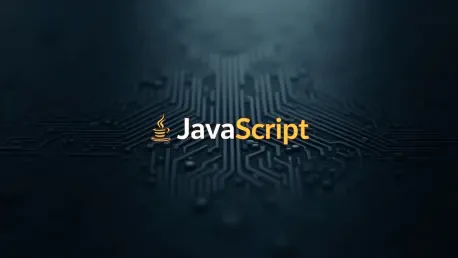JavaScript, a pivotal language for web development, continues to redefine the creative boundaries for developers and artists alike, catalyzing an extraordinary evolution in the realm of digital art. With advancements like P5.js 2.0, developers are now armed with tools that enhance the process of creating generative and interactive art. This version brings variable fonts, JavaScript shaders, wider color spaces, and much-improved pointer events, enabling a smoother artistic experience and greater interactivity. These features make animation and text manipulation more accessible, allowing artists to transcend previous limitations in generative art. This advent encourages numerous artists and developers to explore new paradigms in creating captivating visualizations and applications. The ongoing transformation powered by these updates reflects a broader shift within the development community, where technology is steadily dismantling barriers and democratizing access to sophisticated creative tools.
Exploring Innovations in React
In parallel, React, a leading library in the JavaScript ecosystem, is setting benchmarks with its experimental features such as View Transitions and the Activity Component. These innovations simplify User Interface animations and enhance state management, effectively tapping into the browser’s native functions to deliver smoother transitions. By refining user experience, these components stand as testaments to React’s commitment to performance and usability. As React matures, it continues to bridge the gap between intuitive design and technical complexity, empowering developers to create intricate, yet user-friendly applications. Such strides in the React domain underscore a broader trajectory of innovation where automation, better resource management, and streamlined processes take center stage.
These updates do more than improve usability; they also significantly influence industry trends. By leveraging these experimental features, developers can harness higher performance metrics, an advantage that is crucial in today’s fast-paced tech environment. Furthermore, with each development, React retains its status as a foundational tool in the developers’ toolkit, proving indispensable in creating dynamic applications. This evolution further enriches the user interface landscape, setting new standards and inspiring other platforms to pursue similar advancements. By continuously pushing the boundaries of what’s possible in web development, React is fostering a new era of creative and technical excellence.
SolidJS and Legacy of Innovation
SolidJS, another significant player, demonstrates its influence and efficacy through years of refinement, providing a robust framework known for fine-grained reactivity. This framework’s performance hinges on minimizing runtime overhead and maximizing efficiency—a feat made possible by its signal-based reactivity model. Over the years, SolidJS has shaped the modern frontend architecture, acting as a forerunner in deriving performance through innovative state-handling techniques. Its adoption among major players attests to its robustness, setting precedence for achieving streamlined performance without sacrificing complexity. SolidJS continues to spearhead developments that prioritize computational efficiency and user experience, firmly anchoring itself as a foundational element in future state management strategies.
SolidJS succeeds in exemplifying the power of revolutionary design, where innovation translates into practical solutions that enhance interactivity. By focusing on reducing overhead, it achieves smoother user experiences—a priority in web application development. As it keeps evolving, its methodologies inspire other developers to rethink and reinvent the application development processes. This framework not only guides the industry to optimize but also instills a culture of continuous improvement, effectively shaping how developers approach problem-solving and state management in today’s dynamic ecosystem.
Dynamic Tool Updates
Aside from flagship developments in React and SolidJS, the JavaScript landscape is enriched by numerous other enhancements that cater to diverse creative needs. The release of jsvu 3.0, for instance, simplifies JavaScript engine installation, ensuring developers have optimal tools for crafting nuanced applications. Meanwhile, SmallJS 1.6 embraces the integration of AI, opening avenues to build intelligent and responsive interfaces. Scala.js 1.19.0 continues this trend with WebAssembly optimizations, paving the way for heightened performance and interoperability among different platforms. Similarly, ESLint’s latest updates focus on improved code compatibility, reflecting a meticulous approach to maintaining robust codebases. Spectacle also enters the scene to address presentation needs, offering a streamlined process to create engaging React-based presentations.
Collectively, these updates signal a shared commitment within the developer community to refine and reimagine the tools at their disposal. By empowering developers with sophisticated, multifunctional solutions, these advancements not only redefine the standards of programming but also significantly influence how future applications will be structured and executed. Each iteration invites creators to explore new frontiers, bringing cutting-edge technology into more contexts and ultimately benefiting both users and developers. The concurrent evolutions within different frameworks and tools reflect a unified drive toward crafting seamless, high-performing applications that stand as testaments to innovation.
Future Prospects and Pathways
React, a forefront library in the JavaScript realm, is paving the way with its innovative features like View Transitions and the Activity Component. These advancements streamline User Interface animations while boosting state management, leveraging the browser’s innate capabilities for seamless transitions. By enhancing user experience, these features highlight React’s dedication to performance and usability. As React evolves, it bridges intuitive design and technical intricacies, allowing developers to craft complex, yet user-friendly applications. This progress in the React sphere reflects a broader trend of innovation focused on automation, improved resource management, and efficient processes.
These improvements go beyond usability; they shape industry trends by enabling developers to achieve superior performance metrics, critical in today’s rapid tech landscape. With each update, React proves essential in any developer’s toolkit, crucial for crafting dynamic applications. This progression enriches the user interface panorama, setting new benchmarks and motivating other platforms to pursue similar innovations. By pushing the envelope of web development possibilities, React is ushering in an era of remarkable creative and technical achievement.









